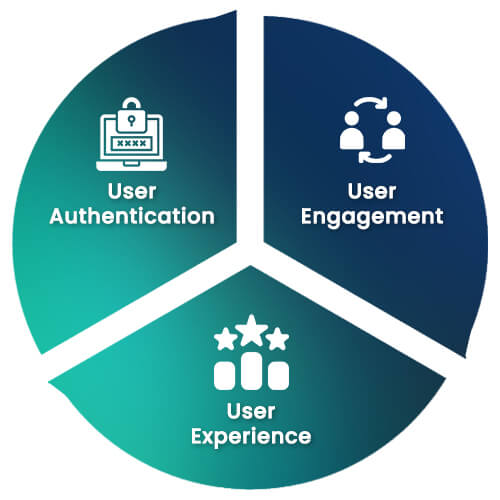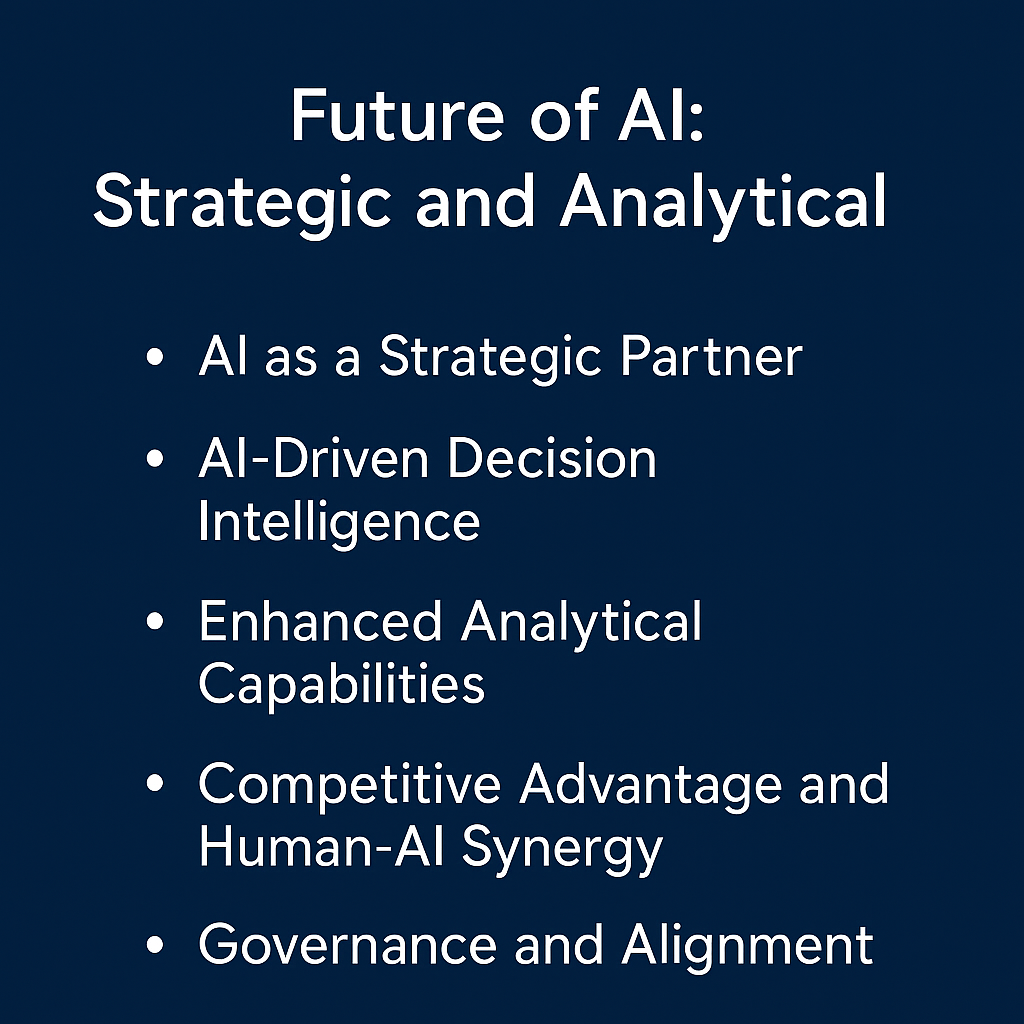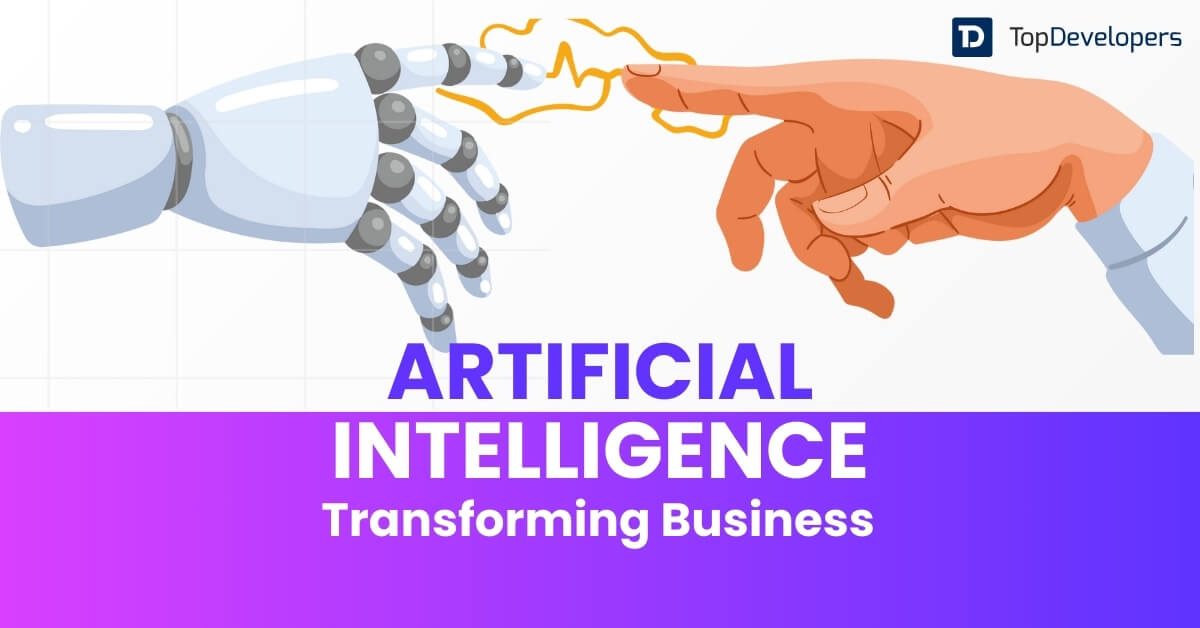
Artificial intelligence makes computers intelligent and human-like thinkers via a wonderful mix of science and engineering. Seeing the most recent studies, it is not hyperbole to declare that scientists want to reach human-level intelligence, as machines can independently make judgments and labor nonstop to complete their duties. Many top artificial intelligence companies are constantly striving to develop customized solutions for various industry sectors through the use of AI-enabled mobile apps and software.
Table of Contents
- What is Artificial Intelligence (AI)—a bookish definition
- The History of Artificial Intelligence
- The Future of Artificial Intelligence (2025 and Beyond)
- The Future of AI Technology: User-Specific
- Future of AI: Strategic and Analytical
- The Future of AI Technology: Software Development
- AI-Powered Coding and Automation
- Application Modernization and Technical Debt Reduction
- Enhanced Security with AI-Powered Developments
- Rise of Low-Code/No-Code and Integrated Development Platforms
- Smarter Project Management and Predictive Analytics
- Embedded Systems and IoT Development
- Realistic, Measured Use of Generative AI
- Platform Engineering and Developer Experience
What is Artificial Intelligence (AI)—a bookish definition
Though Britannica defines it as “the ability of a digital computer or computer-operated robot to perform tasks commonly associated with intelligent beings,” various definitions established for artificial intelligence during the past decade have Artificial intelligence is the theory and development of computer systems capable of executing activities ordinarily requiring human intelligence, such as learning, reasoning, problem-solving, perception, and language understanding.”
The History of Artificial Intelligence
Artificial intelligence (AI) has over a century of history distinguished by innovative concepts, technology benchmarks, and rapid development from theory to practical influence.
-
Early Foundations (1940s–1950s)
- 1940s: Early efforts in computing and codebreaking, notably the employment of machines to crack the Enigma code during World War II, helped shape artificial intelligence.
- 1950: Alan Turing first put forth the idea of machine intelligence and the Turing Test—a means of assessing a machine’s capacity for human-like intelligence.
- 1955–1956: Often referred to as the “father of artificial intelligence,” John McCarthy developed the name and coordinated the Dartmouth Summer Research Project, therefore formally launching artificial intelligence as a discipline of study.
-
Early AI Programs and Progress (1950s–1970s)
- 1956: Allen Newell and Herbert Simon’s Logic Theorist turned out to be among the earliest artificial intelligence projects able to solve mathematical problems.
- 1958: Frank Rosenblatt created the perceptron, an early artificial neural network that set the foundation for current deep learning in 1958.
- 1960s: Notable developments in the 1960s included Shakey, the first mobile intelligent robot, and ELIZA, the first chatbot simulating human discourse.
- 1970s: High expectations and delayed development in the 1970s caused AI research to suffer setbacks that resulted in lower funding and what came to be known as the “AI winter.”
-
Expert Systems and Renewed Interest (1980s–1990s)
- 1980s: AI recovered with the creation of expert systems such as XCON and MYCIN, which addressed industry and medical real-world challenges. Mercedes-Benz also tested early, automated automobiles.
- 1997: IBM’s Deep Blue proved artificial intelligence’s rising ability to solve problems by defeating global chess champion Garry Kasparov.
-
Rising of Deep Learning and Machine Learning (2000s–2010s)
- 2000s: Machine learning and neural networks emerged from developments in processing power and data availability.
- 2012: AlexNet, a convolutional neural network, launched a new era for artificial intelligence by attaining record performance in image recognition and hence igniting deep learning.
- 2016: Thanks to the complexity of the game, Google DeepMind’s AlphaGo defeated the world champion in Go—a feat hitherto deemed impossible for machines.
- 2018–2020: Transformer architectures (such as BERT and GPT) transformed natural language processing so that machines might produce human-like writing by understanding and generating.
-
Recent Milestones and Modern AI (2020s)
- 2020: OpenAI published GPT-3, a big language model able to produce coherent, contextually relevant text, and Google DeepMind AlphaFold solved the protein folding challenge, hence transforming biology.
- 2022–2023: ChatGPT and GPT-4 brought conversational AI into popular use in 2022–2023, driving chatbots, virtual assistants, and creative tools.
- Ongoing: From recommendation engines and voice assistants to autonomous cars and advanced robotics, artificial intelligence has become an integral part of our daily lives. Today, artificial intelligence has been used not only to make machines powerful and smart but also in a notable development in mobile and web app development. Increasing sales and expanding business using AI-enabled technologies is not unusual.
The Future of Artificial Intelligence (2025 and Beyond)
With significant ramifications for web development, design, and programming, artificial intelligence (AI) is poised to revolutionize sectors. Building on trends like AI-driven personalization, immersive 3D features, and sustainable design, artificial intelligence will propel innovation in personal websites, developer tools, and user-centric experiences by 2025. Key forecasts below have a bearing on your areas of interest.
-
Hyper-Personalized Web Experiences
- Future Trend: AI will utilize sophisticated machine learning to provide hyper-personalized, real-time content catered to particular user tastes, behaviors, and environments.
- Impact on Web Development: Personal websites will dynamically change layouts, information, and images, therefore affecting web development. For instance, a freelancer’s portfolio might prioritize work based on a visitor’s industry, giving preference to tech over artistic projects.
- Tool: Custom LLMs incorporated via APIs, enhanced versions of Wix ADI, Framer AI, or both.
- Relevance: Extends the 2025 trend of AI-driven personalization, thereby enhancing the engagement- and conversion-oriented focus of websites.
- Programming Note: While JavaScript fits rapid prototyping of dynamic layouts, TypeScript’s type safety guarantees dependable artificial intelligence-driven features.
-
AI-Powered Design Automation
- Future Trend: AI will automate difficult design chores, creating layouts, color schemes, and animations from basic cues, hence cutting design time.
- Impact on Web Development: Tools like Midjourney or Figma’s AI plugins will provide organic shapes, bright color palettes, or retro-futuristic aesthetics for personal sites, therefore impacting web development. Customizing will take center stage for developers, instead of creation.
- The tools include Canva AI, Adobe Sensei, and no-code apps such as Webflow that have AI connections.
- Relevance: It lets non-designers apply modern web design by aligning with 2025 trends, including bold typography and collage aesthetics.
- Programming Note: While TypeScript guarantees sustainable codebases for large-scale designs, JavaScript’s adaptability is perfect for including AI-generated materials.
-
Conversational and Multimodal Interventions
- Future Trend: AI will drive multimodal, gesture-based, voice-activated, and motion-activated interfaces, thereby increasing the accessibility and interactivity of websites.
- Impact on Web Development: Personal websites will improve user experience by including gesture-driven storytelling or voice navigation—e.g., “Show my portfolio.”
- The tools include the Web Speech API, Alan AI, and multimodal models that combine text, voice, and images.
- Relevance: Supporting inclusiveness and involvement builds on 2025 trends such as experimental navigation and voice-activated interfaces.
- Programming Note: While JavaScript allows rapid voice feature prototypes, TypeScript’s strong typing provides sophisticated multimodal integrations.
-
AI Enhanced Developer Productivity
- Future Trend: Beyond autocompletion, artificial intelligence coding assistants will create whole modules, maximize performance, and aggressively debug.
- Impact on Web Development: Using AI to create TypeScript components for 3D parts or JavaScript animations for micro-interactions, developers will create personal websites faster.
- Tools: Grok 3 for code recommendations from xAI, GitHub Copilot 2.0, or JetBrains AI Assistant.
- Relevance: This aligns with the benefits of artificial intelligence in web development and supports 2025 trends, such as sustainable web design, by optimizing code for efficiency.
- Programming Note: While JavaScript’s simplicity fits repeated exploration, TypeScript’s architecture maximizes artificial intelligence tool accuracy.
-
Ethical and Sustainable AI Integration
- Future Trend: Driven by laws and consumer demand, future trends in artificial intelligence will give ethical issues (bias reduction, transparency) top priority as well as sustainability (energy-efficient models).
- Impact on Web Development: Personal websites will increasingly adopt privacy-centric designs and utilize green hosting, while AI optimizes assets to reduce energy consumption, thereby influencing web development.
- Tool: TinyPNG, GreenGeeks, or Fathom Analytics—AI-driven compression technologies.
- Relevance: Ensures trust and performance by supporting 2025 trends, including sustainable design with an eye on privacy.
- Programming Note: While JavaScript provides lightweight scripts that contribute to environmentally friendly webpages, TypeScript’s maintainability supports adherence to ethical standards.
-
Content Creation and SEO: AI
- Future Trend: AI will create voice search capabilities, forecast search patterns, and produce SEO-optimized content.
- Impact on Web Development: Personal websites ranked higher with fast-loading pages, conversational keywords, and AI-crafted meta tags.
- Tools: Grok 3 for content ideas, ChatGPT, SurferSEO
- Relevance: Improves SEO methods from past searches (e.g., “AI in Web Dev: Tools, Trends & Benefits”), hence increasing exposure for trends including minimalism and maximalism.
- Programming Note: TypeScript guarantees strong data handling for AI-enabled software to increase sales, while Next.js with TypeScript supports SEO-friendly frameworks.
The Future of AI Technology: User-Specific
Artificial intelligence will be subtly incorporated throughout the whole information technology industry in the future. The result implies that every IT solution developed for any sector would probably have artificial intelligence guiding it to permit customizing and improve tool capability. This forecast is clear even now since artificial intelligence and machine learning are quickly changing conventional computer programming. More complex software programs will result from it. Evaluating the popularity and bright future of software solutions, organizations collaborating with leading AI development companies will have a strategic edge to keep ahead of the curve and maximize AI for their particular demands.
AI researchers hold the future of artificial intelligence; they are not stopping anywhere in applying the technology to produce standards in many manufacturing and business areas.
Artificial intelligence currently powers three fundamental jobs that drive any company nowadays and will flourish in the future. Here are three such tasks:
-
User Authentication
Any mobile or online application’s security consists of user authentication. Given the annual global rate of 5.4 billion malware attacks, users must exercise extreme caution to ensure their verification.
In the future, we expect to apply artificial intelligence widely for the following listed recognitions.
- Facial recognition
- Speech recognition
- Object recognition
- Biometric recognition
- Image recognition
Such recognitions enable software intelligence to authenticate users, thereby preventing malware and other dubious accesses.
-
User Engagement
From recommendation to user interaction, artificial intelligence technology will open its path to keep consumers occupied with business applications showcasing the company’s products and services, thereby brightening the future of artificial intelligence. Stated differently, AI has been enabling your customers to interact and engage with your applications, thereby lowering the bounce rate. More involvement directly means more application, where the chances of conversation multiply several times. Future artificial intelligence will tailor most apps to incorporate this technology, thereby increasing user involvement.
-
User Experience
UI/UX research has attracted billions of dollars. Currently, most studies focus on artificial intelligence algorithms to better understand human behavior and decision-making. These are some artificial intelligence features applied to enhance user experience.
AI systems are designed to monitor and track user behavior as it navigates the website or application. Learning the user’s pattern and selections on the UI requires tracking cursor movements, touching or pressing buttons, and even eye motions.
AI predictions: On the user interface and the other pages of a software, web, or mobile system, the predictions made by artificial intelligence help decide particular features, facilities, and components. Moreover, using user data, artificial intelligence can suggest perfect corporate plans. In this sense, giving your people what they desire in the future will help enhance the user experience.
AI solutions, specifically artificial intelligence technologies, can provide remarkable features without constraints for mobile applications and websites. Recent feathers in the cap are AI-powered chatbots like Google Bard and ChatGPT. By promptly and continuously addressing consumer inquiries and issues, these chatbots contribute to delivering the best possible user experience.
Future of AI: Strategic and Analytical
The fifth generation is now making a significant impact. Combining a comprehensive analytical examination of unstructured data with knowledge-based artificial intelligence to provide artificial intelligence systems as a service and support for decision-making, this generation exceeds all its predecessors by a long margin.
After four generations of development, AI specialists estimate the revolution will be most intense in the next decade. Future artificial intelligence technologies will be based on computer programming algorithms, as well as future robotics (microbots and cyborgs).
-
AI as a Strategic Partner
AI is transcending its conventional function as a data processor by 2025 to become a real strategic partner. Real-time analysis of vast amounts of data, pattern recognition, market trend prediction, and actionable insights produced by modern artificial intelligence systems guide long-term corporate strategy development. Leaders now employ AI-driven analytics to model scenarios, evaluate risks, and replicate the possible results of many strategic choices rather than depending just on intuition or previous data.
-
AI-Driven Decision Intelligence
A big trend is the emergence of “decision intelligence,” in which integrated artificial intelligence technologies and predictive analytics directly guide and automate corporate decisions rather than merely offer insights. AI agents, for instance, are becoming indispensable parts of business systems since they automate difficult chores, including demand forecasting, supply chain optimization, and customer interaction, while providing recommendations consistent with corporate objectives.
-
Enhanced Analytical Capabilities
Analytical capability of artificial intelligence helps companies to:
- Faster than human analysts, identify minor trends and developing hazards.
- For a complete strategic vision, compile and synthesize data from many sources.
- Run virtual strategy simulations to enable leaders to assess the effects of various choices before allocating funds.
- Constant strategy adaptation, depending on real-time data, helps make planning more flexible and responsive.
-
Competitive Advantage and Human-AI Synergy
AI is starting to be a competitive advantage since it generates and assesses tactics that either match or exceed human expertise. The most effective companies, however, will mix human creativity and judgment with AI’s analytical speed and scale to guarantee that strategic decisions are both contextually sound and data-driven.
-
Governance and Alignment
Growing importance of artificial intelligence is driving strong governance structures to guarantee that AI systems fit ethical standards, corporate goals, and legal obligations 2. The maximum strategic value of artificial intelligence and trust building depends on this.
The industries listed below primarily attract governments worldwide to fund artificial intelligence research and development aimed at managing national growth and responding to disasters. For example, events like Fukushima and Chernobyl made clear how urgently small flying robots capable of analyzing catastrophic damage and gathering data from inaccessible areas are needed.
In a few months, the previously unheard-of COVID epidemic destroyed the global healthcare system. AI-enabled surgery robots and medical assistants can significantly assist in providing healthcare services, even in the absence of fatal diseases. Future ideas for some artificial intelligence goods include gathering and working on the foundations of cyber-physical systems for digital twins and the human-machine co-bots concept.
Although governments all around devote billions of dollars on AI research and development for the following areas, private businesses fail to maintain pace in other sectors such as
- Banking and Finance
- Retail and eCommerce
- Food and grocery delivery
- Beauty and cosmetics
- Real estate and rentals
- Tours and travels
- Ticket booking
- Transportation and logistics
- Music and entertainment (streaming)
Even more research is being done to make machines human-friendly, and artificial intelligence has grown to be a fundamental factor for practically all sectors. Masters will be able to instruct or train their AI-enabled equipment and devices using interactive and scalable procedures with creative means. Among the fields where everyone is now focusing on the direction of artificial intelligence is
- Large-scale mechanical learning
- Deep knowledge
- Learned reinforcement
- Robots
- Computer vision
- Personal computation
- Process of natural language acquisition
- IoT: Internet of Things
- Neuromorphic technologies
The Future of AI Technology: Software Development
From USD 86.9 billion to an amazing USD 407.0 billion, artificial intelligence is expected to grow at a whopping CAGR of 36.2%, according to Markets and Markets Research. The same website anticipates excellent prospects in the worldwide artificial intelligence industry next year.
By 2025, artificial intelligence technology in software development will undergo a revolutionary shift from experimental to large-scale, pragmatic deployment. AI is changing software development as follows:
-
AI-Powered Coding and Automation
The developer process nowadays consists mostly of AI-driven technologies. Real-time code suggestions, automated repetitious chores, and debugging assistance come from coding assistants such as GitHub Copilot and related systems. This speeds up development and lowers technical debt and human error, thereby freeing engineers to concentrate on more difficult, creative tasks.
-
Application Modernization and Technical Debt Reduction
Modernizing legacy systems that were once too expensive or difficult to update is becoming financially feasible thanks to artificial intelligence. AI helps firms lower technical debt and increase the security and maintainability of their software assets by automating code analysis, refactoring, and vulnerability detection.
-
Enhanced Security with AI-Powered Developments
The top concern is security; artificial intelligence leads in integrating development techniques. By automatically identifying, explaining, and even fixing vulnerabilities in code, AI-powered technologies help to guarantee that security is ingrained at all phases of the development life. This proactive strategy greatly lowers risk and raises general software quality.
-
Rise of Low-Code/No-Code and Integrated Development Platforms
Low-code and no-code platforms let artificial intelligence democratize software development by allowing non-developers to rapidly create apps. Integrated development platforms are also simplifying processes, lowering tool sprawl, and freeing developers from menial operational and setup chores at the same time.
-
Smarter Project Management and Predictive Analytics
Predictive analytics in AI-driven project management solutions helps to allocate resources, maximize deadlines, and see possible bottlenecks. This leads to more effective project delivery and closer alignment with corporate goals.
-
Embedded Systems and IoT Development
As smart devices proliferate, artificial intelligence finds increasing use in IoT development and embedded systems. Driven by artificial intelligence, DevSecOps ideas are being applied in various fields to guarantee strong security and production for the following generation of connected devices.
-
Realistic, Measured Use of Generative AI
Although generative artificial intelligence is becoming more and more popular, developers are approaching their work realistically by employing AI as an assistant rather than a substitute. The emphasis is on augmenting human ingenuity and knowledge, not on totally automating software development.
-
Platform Engineering and Developer Experience
Powered by artificial intelligence, internal development platforms (IDPs) are streamlining technological complexity, allowing self-service, and including real-time feedback into developer processes. This change helps developers to become more independent and effective.
The Future is Near!
Artificial intelligence is advancing at an unprecedented pace, prompting IT outsourcing companies to incorporate the latest trends into their own operations. Having said that, top developers would harness the advantages of the most recent artificial intelligence technologies to create a front end and a back end to create a product that speeds sales and delivers an unmatched user experience, ensuring the super success of the product.
FAQs
What are the top AI trends to expect in 2025 and beyond?
The future of AI in 2025 includes hyper-personalization, multimodal interfaces, and ethical AI. AI will power voice-activated navigation and dynamic web layouts, enhancing user experience. Tools like xAI’s API (https://x.ai/api) will drive personalization, while sustainable AI aligns with eco-friendly web design. These AI trends in 2025 will transform personal websites, making them more interactive and user-centric.
How will AI improve user experience on websites in the future?
AI will enhance user experience by enabling hyper-personalized content, biometric authentication, and conversational interfaces. For example, personal websites will adapt portfolios to user interests, using AI-driven personalization (a 2025 trend). Voice navigation and gesture controls, powered by Web Speech API, will improve accessibility, aligning with future AI goals for seamless, intuitive interactions on modern websites.
What role will AI play as a strategic partner in businesses?
AI as a strategic partner will provide decision intelligence and competitive advantage through human-AI synergy. By 2025, AI will analyze data for insights, like predicting user behavior for web design. Businesses can use tools like Grok 3 (https://x.ai/grok) to strategize, aligning with AI strategy trends. Such an approach ensures smarter decisions, governance, and alignment with ethical standards.
How will AI-driven decision intelligence impact web development?
AI-driven decision intelligence will optimize web development by predicting trends and user needs. For instance, using tools like Framer AI, AI can suggest layouts for 2025 trends like immersive 3D elements. It enhances analytical capabilities, ensuring websites are SEO-friendly and user-focused. The future of AI in web development will streamline workflows, making sites more efficient and engaging.
What are the challenges of implementing AI in the future?
The future of AI faces challenges like ethical concerns, skill gaps, and costs. Implementing ethical AI requires bias mitigation and GDPR compliance, impacting privacy-centric web design. Developers need upskilling for AI tools, and premium APIs (e.g., https://x.ai/api) may raise costs. Balancing automation with creativity ensures AI trends in 2025 enhance, not hinder, human-driven innovation in web development.
 Avantika Shergil
| May 13, 2025
Avantika Shergil
| May 13, 2025
Avantika Shergil is a technology enthusiast and thought leader with deep expertise in software development and web technologies. With over 8 years of experience analyzing and evaluating cutting-edge digital solutions, Avantika has a knack for demystifying complex tech trends. Her insights into modern programming frameworks, system architecture, and web innovation have empowered businesses to make informed decisions in the ever-evolving tech landscape. Avantika is passionate about bridging the gap between technology and business strategy, helping businesses build customized software and website, and understand about different tools to leverage effectively for their ventures. Explore her work for a unique perspective on the future of digital innovation.







